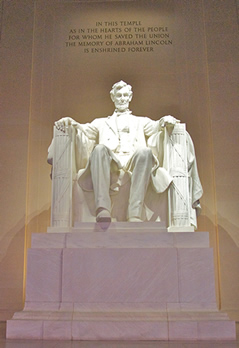
Courtesy of Ed Yourdon, Flickr's Creative Commons
Lincoln, long viewed by the American people as a symbol of honesty, integrity, and humanity, died from an assassin’s bullet in April 1865. While the nation did not build a national monument to commemorate Lincoln until the 20th century, Americans began expressing their desire for an appropriate memorial soon after his death. By 1867, two groups were making plans to commemorate his memory in the nation’s capital. One group, led by a black woman born into slavery, began to collect money to honor the author of the Emancipation Proclamation. In 1867, Congress incorporated the Lincoln Monument Association to construct a memorial; however, it was not until 1911, with the creation of a new Lincoln Memorial Commission, that work proceeded to determine a location and design for the monument. The Senate Park Commission, also known as the McMillan Commission, chose West Potomac Park as the location for the memorial. Congress approved a design by New York architect Henry Bacon. Construction of the memorial began in 1914 and it was ready for visitors in 1922.
Henry Bacon designed the memorial after the Greek Temple known as the Parthenon with the idea that a memorial to the man who defended democracy should be modeled after a structure from the birthplace of democracy. As visitors approach the memorial--which is 190 feet long, 119 feet wide, almost 100 feet high, and constructed of granite, marble, and limestone--they face 98 granite and marble stairs that lead directly inside the memorial to the Lincoln statue. Climb the steps, they first see the 36 Doric columns around the memorial chamber that represent the States in the Union at the time of Lincoln’s death. Rows of Ionic columns divide the interior of the memorial into three chambers.
The north and south side chambers contain carved inscriptions of Lincoln’s Second Inaugural Address and his Gettysburg Address. Jules Guerin painted the two large murals placed above these inscriptions. The murals portray principles that guided Lincoln throughout his life including Freedom, Liberty, Justice, the Law, Unity, Fraternity, and Charity.
Between the north and south chambers of the memorial is the grand central hall that contains the Lincoln statue, which Daniel Chester French designed and the Piccirilli Brothers carved. The statue stands 19 feet tall and 19 feet wide. Lincoln is in a seated position and appears lost in thought and contemplation with one hand clenched and the other more relaxed. The statue's design captures Lincoln's determination, compassion, and thoughtfulness.
Lincoln Memorial Commission president, William Howard Taft, presented the finished memorial to President Warren G. Harding, who accepted the memorial for the American people on May 30, 1922. Robert Todd Lincoln, Lincoln’s only surviving son, was present at the dedication. Dr. Robert Moton, president of Tuskegee Institute, gave the keynote address. While speaking to a largely segregated audience, Dr. Moton promoted equality among the races.
Since that time, millions of people have visited the Lincoln Memorial for a variety of different reasons. Some come on a school trip or a family vacation, while others are drawn to the memorial for its symbolic representation of peace, strength, and democratic principles. Highly significant Civil Rights events of the 20th Century took place at the Lincoln Memorial.
In 1939, after being denied the opportunity to sing in Constitution Hall because of her race, the great African American contralto Marian Anderson sang to a crowd of 75,000 people at the Lincoln Memorial. With this event, the free Easter Sunday Concert of 1939, the Lincoln Memorial became not only a place to remember and honor an important president, but also a place to represent the struggle to extend freedom and equality to every American citizen.
On August 28, 1963, the Lincoln Memorial would once again hold center stage in the struggle for equality in the United States. On this day, Dr. Martin Luther King, Jr. delivered his famous “I Have a Dream” speech. Dr. King, along with 200,000 other people (50,000 of whom were white), assembled at the memorial for the “March on Washington for Jobs and Freedom.” The 200,000 who gathered there represented a broad diverse mix of Americans. People of every occupation and religion were present along with celebrities such as Marlon Brando, Bob Dylan, and others who performed. The crowd listened to performances by Mahalia Jackson, Marian Anderson, and Odetta. The grand finale of the day, Dr. King’s “I Have a Dream” speech, left the American people with the true spirit of the Civil Rights Movement.
The Lincoln Memorial has been the site of many large public gatherings and protests. For millions of people, Americans and others, the Lincoln Memorial is an inspiring and enduring symbol of freedom.
Lincoln Memorial National Memorial, a unit of the National Park System, stands in the center of Lincoln Memorial Circle, where 23rd St. NW meets Constitution and Independence Aves. in West Potomac Park in Washington, DC. Click here for the National Register of Historic Places file: text and photos. The Lincoln Memorial is open to the public 24 hours a day. Rangers are on duty to answer questions from 9:30am to 11:30pm daily. For more information, visit the National Park Service Lincoln Memorial National Memorial website or call 202-426-6841.
The Lincoln Memorial has been documented by the National Park Service’s Historic American Buildings Survey. It is also featured in the National Park Service's Washington, DC Travel Itinerary, the American Presidents Travel Itinerary, and the We Shall Overcome: Historic Places of the Civil Rights Movement Travel Itinerary.
The Lincoln statue of the Lincoln Memorial is discussed in the online lesson plan, Chesterwood: The Workshop of an American Sculptor, which is produced by the National Park Service Teaching with Historic Places program. Other TwHP lesson plans that relate to Abraham Lincoln include, Choices and Commitments: The Soldiers at Gettysburg, Lincoln Boyhood National Memorial: Forging Greatness during Lincoln's Youth, and Lincoln Home National Historic Site: A Place of Growth and Memory.
Last updated: June 18, 2019
